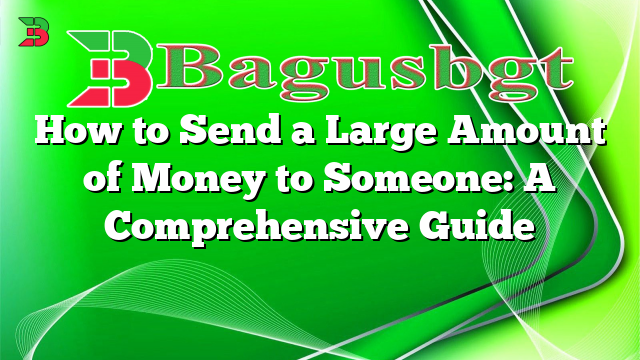Hello there! Sending a large amount of money to someone can be a daunting task, especially if you are unfamiliar with the various options available. In this article, we will explore different methods to securely send a substantial sum of money to your desired recipient. Whether you are making an international transfer or sending money domestically, this guide will provide you with detailed information on how to navigate the process efficiently and securely.
1. Bank Wire Transfer
A bank wire transfer is one of the most common methods used to send large amounts of money. It allows you to electronically transfer funds from your bank account to another person’s account. To initiate a wire transfer, you will need the recipient’s bank account number, routing number, and any additional information required by your bank. While bank wire transfers are generally secure and reliable, they can be quite expensive, especially for international transfers. Additionally, they may take a few business days to process.
2. Online Payment Platforms
Online payment platforms like PayPal, Venmo, and Skrill offer a convenient way to send money quickly and securely. These platforms allow you to link your bank account or credit card to transfer funds to another individual. While online payment platforms are often faster and more cost-effective than bank wire transfers, they may have limits on the amount you can send. Additionally, both the sender and recipient need to have accounts on the same platform for the transaction to occur.
3. Cashier’s Check or Money Order
If you prefer a more traditional approach, you can send a large amount of money using a cashier’s check or money order. These payment methods are typically issued by banks or financial institutions and provide a secure way to transfer funds. However, they can be time-consuming, as you may need to visit a bank in person to obtain the check or money order. Additionally, there may be fees associated with these services.
4. Cryptocurrency
In recent years, cryptocurrencies like Bitcoin have gained popularity as a means of transferring large sums of money. Cryptocurrencies offer fast, secure, and borderless transactions, making them an attractive option for international transfers. However, it’s important to note that the value of cryptocurrencies can be volatile, so both the sender and recipient should be knowledgeable about the associated risks. Additionally, the process of buying and selling cryptocurrencies may involve fees.
5. Escrow Services
If you are involved in a high-value transaction, such as purchasing real estate or a luxury item, using an escrow service can provide an added layer of security. Escrow services act as intermediaries, holding the funds until both parties meet the agreed-upon conditions. This ensures that the money is only released when all requirements are met, protecting both the buyer and seller. However, escrow services often charge fees for their services, and it’s essential to choose a reputable provider.
6. International Bank Draft
When sending a large amount of money internationally, an international bank draft can be a reliable option. This payment method involves purchasing a draft from your bank, which is then sent to the recipient’s bank for deposit. International bank drafts are often available in various currencies and can be a secure way to transfer funds. However, they may incur fees and can take time to reach the recipient, particularly if it requires international mail services.
7. Peer-to-Peer (P2P) Transfers
Peer-to-peer transfers enable individuals to send money directly to each other without the involvement of traditional financial institutions. Platforms like Zelle, Google Pay, and Apple Pay allow users to transfer funds quickly and easily using just their mobile devices. P2P transfers are typically free or have minimal fees, making them an attractive option for sending large amounts of money domestically. However, both the sender and recipient must have accounts on the same platform.
8. Prepaid Debit Cards
Prepaid debit cards can be a practical solution for sending a large amount of money, especially if the recipient does not have a bank account. You can load the desired amount onto the prepaid card and provide it to the recipient, who can then use it like a regular debit card. While prepaid debit cards offer convenience, they often come with activation fees, monthly fees, and limits on the maximum amount you can load onto the card.
9. Mobile Wallets
Mobile wallets, such as Apple Pay and Google Wallet, allow users to store money digitally and send it to others using their mobile devices. These wallets are linked to your bank account or credit card, enabling you to transfer funds to someone else’s mobile wallet with ease. While mobile wallets offer convenience and speed, they may have transaction limits and could be subject to additional fees.
10. Traditional Mail
Although less common in today’s digital age, sending money through traditional mail is still an option. However, it is crucial to take precautions to ensure the funds’ safety. Use registered or certified mail and consider purchasing insurance for the package. Splitting the money into multiple envelopes or using a money order can also add an extra layer of protection. Keep in mind that sending cash through the mail is generally not recommended, as it can be easily stolen.
Alternative Ways to Send a Large Amount of Money
Aside from the methods mentioned above, there are a few alternative ways to send a large amount of money securely:
– Direct bank deposit: If the recipient has a bank account, you can deposit the funds directly into their account. This method is often free and eliminates the need for the recipient to take any additional steps.
– Wire transfer services: Some companies specialize in facilitating wire transfers, offering competitive exchange rates and lower fees compared to traditional banks.
– Financial advisors: If you require assistance in sending a large amount of money, consulting with a financial advisor can provide valuable guidance and ensure that you make informed decisions throughout the process.
Table: Comparison of Different Methods to Send a Large Amount of Money
Method |
Advantages |
Disadvantages |
|---|---|---|
Bank Wire Transfer |
– Widely accepted – Secure – Reliable |
– Expensive fees – Lengthy processing times |
Online Payment Platforms |
– Quick and convenient – Lower fees compared to wire transfers |
– Sender and recipient must have accounts on the same platform – Transaction limits |
Cashier’s Check or Money Order |
– Secure – Can be used without a bank account |
– Time-consuming – Potential fees |
Cryptocurrency |
– Fast and secure – Borderless transactions |
– Volatile value – Fees involved |
Escrow Services |
– Enhanced security for high-value transactions |
– Service fees – Choosing a reputable provider is crucial |
International Bank Draft |
– Secure – Available in various currencies |
– Fees – Delivery time |
Peer-to-Peer (P2P) Transfers |
– Quick and easy – Minimal fees |
– Both parties must have accounts on the same platform |
Prepaid Debit Cards |
– No need for a bank account – Convenient |
– Activation and monthly fees – Maximum load limits |
Mobile Wallets |
– Convenience – Speed |
– Transaction limits – Possible additional fees |
Traditional Mail |
– Can be used if precautions are taken |
– Risk of theft – Not recommended for sending cash |
Frequently Asked Questions (FAQ)
Q: Are wire transfers the most secure method to send a large amount of money?
A: While wire transfers are generally secure, it’s important to ensure that you provide the correct recipient information to avoid any potential issues. Additionally, consider using additional security measures, such as two-factor authentication, if available.
Q: Can I cancel a wire transfer once it has been initiated?
A: In most cases, wire transfers cannot be canceled once they have been initiated. It is crucial to double-check all the details before initiating the transfer to avoid any mistakes.
Q: Are there any limits on the amount I can send through online payment platforms?
A: Yes, most online payment platforms have limits on the amount you can send within a specific timeframe. These limits vary depending onthe platform and may be subject to verification and account limits. It’s important to check the platform’s terms and conditions for specific information on sending limits.
Q: Are there any risks associated with using cryptocurrencies to send a large amount of money?
A: Yes, cryptocurrencies can be volatile, meaning their value can fluctuate rapidly. It’s essential to be aware of these fluctuations and understand the potential risks involved. Additionally, it’s crucial to ensure that you are sending funds to the correct wallet address to avoid any loss of funds.
Q: Can I use a combination of different methods to send a large amount of money?
A: Yes, depending on your specific needs and preferences, you can use a combination of methods. For example, you may choose to send a portion of the funds through a bank wire transfer and another portion through an online payment platform. However, it’s important to consider any associated fees and limitations with each method.
Conclusion
Sending a large amount of money to someone requires careful consideration of various factors, including security, speed, cost, and convenience. In this comprehensive guide, we have explored ten different methods for sending large sums of money, ranging from traditional bank wire transfers to modern peer-to-peer payment platforms. Each method has its own advantages and disadvantages, and it’s important to choose the one that best suits your specific needs and circumstances.
Remember to prioritize security and double-check all the recipient’s information before initiating any transfer. Additionally, be aware of any fees, transaction limits, and potential risks associated with each method. By following these guidelines and making informed decisions, you can successfully send a large amount of money to someone with confidence and peace of mind.
 Bagus Banget Kumpulan Informasi terbaru dari berbagai sumber yang terpercaya
Bagus Banget Kumpulan Informasi terbaru dari berbagai sumber yang terpercaya

